Technology
PROPERTY| ROTATIONAL MOULDING
Rotational molding is an atmospheric pressure process that produces nearly stress-free parts. The fact that there are no stresses on the melt as it is shaped is a major advantage that rotational molding has over all other manufacturing methods for plastics parts. Also, as there are no forces on the plastic melt during forming, rotational molds can have thin walls and are relatively inexpensive to fabricate. For simple parts, mold delivery times can be a few days or weeks. Modern, multi-armed machines allow multiple molds of different sizes and shapes to be run at the same time. With proper mold design, complex parts, such as double-walled containers, that are difficult or impossible to mold by any other method, can be rotationally molded. With correct process control, the wall thickness of rotationally molded parts is quite uniform, unlike structural blow molding or twin-sheet thermoforming.
SHRINKAGE
In the rotational moulding process the mould only restrains the external surface of the moulded part. The decrease in volume that takes place during the solidification process causes shrinking that is distributed in all directions, even as a function to the restrictions. A moulded part that is very restricted (due to the presence of metal inserts, stiffening ribs or other) will show shrinkage that is less than average in the direction of the restraint and higher than average in the directions where the shrinkage can take place freely.
The realisation of a good quality product requires special attention right from the early design stages: attention to detail during the concept stages of the product can eliminate some problems: for example, warpage and distortion can be reduced by inserting stiffening ribs on large flat surfaces and avoiding sharp corners and severe mould shrinkage restrictions.
